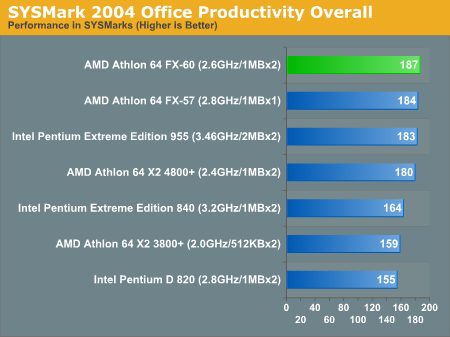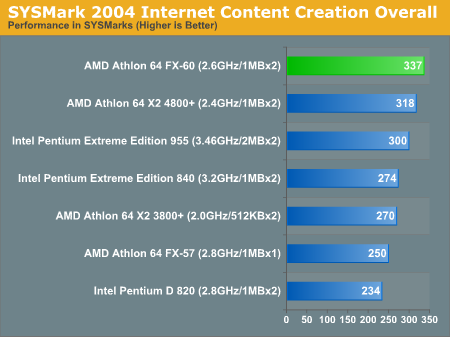AMD Athlon 64 FX-60: A Dual-Core farewell to Socket-939
by Anand Lal Shimpi on January 9, 2006 11:59 PM EST- Posted in
- CPUs
Overall Performance using SYSMark 2004
Office Productivity SYSMark 2004
SYSMark's Office Productivity suite consists of three tests, the first of which is the Communication test. The Communication test consists of the following:
ICC SYSMark 2004
The first category that we will deal with is 3D Content Creation. The tests that make up this benchmark are described below:
Office Productivity SYSMark 2004
SYSMark's Office Productivity suite consists of three tests, the first of which is the Communication test. The Communication test consists of the following:
"The user receives an email in Outlook 2002 that contains a collection of documents in a zip file. The user reviews his email and updates his calendar while VirusScan 7.0 scans the system. The corporate web site is viewed in Internet Explorer 6.0. Finally, Internet Explorer is used to look at samples of the web pages and documents created during the scenario."The next test is Document Creation performance:
"The user edits the document using Word 2002. He transcribes an audio file into a document using Dragon NaturallySpeaking 6. Once the document has all the necessary pieces in place, the user changes it into a portable format for easy and secure distribution using Acrobat 5.0.5. The user creates a marketing presentation in PowerPoint 2002 and adds elements to a slide show template."The final test in our Office Productivity suite is Data Analysis, which BAPCo describes as:
"The user opens a database using Access 2002 and runs some queries. A collection of documents are archived using WinZip 8.1. The queries' results are imported into a spreadsheet using Excel 2002 and are used to generate graphical charts."

ICC SYSMark 2004
The first category that we will deal with is 3D Content Creation. The tests that make up this benchmark are described below:
"The user renders a 3D model to a bitmap using 3ds max 5.1, while preparing web pages in Dreamweaver MX. Then the user renders a 3D animation in a vector graphics format."Next, we have 2D Content Creation performance:
"The user uses Premiere 6.5 to create a movie from several raw input movie cuts and sound cuts and starts exporting it. While waiting on this operation, the user imports the rendered image into Photoshop 7.01, modifies it and saves the results. Once the movie is assembled, the user edits it and creates special effects using After Effects 5.5."The Internet Content Creation suite is rounded up with a Web Publishing performance test:
"The user extracts content from an archive using WinZip 8.1. Meanwhile, he uses Flash MX to open the exported 3D vector graphics file. He modifies it by including other pictures and optimizes it for faster animation. The final movie with the special effects is then compressed using Windows Media Encoder 9 series in a format that can be broadcast over broadband Internet. The web site is given the final touches in Dreamweaver MX and the system is scanned by VirusScan 7.0."












94 Comments
View All Comments
Betwon - Tuesday, January 10, 2006 - link
Yes, It is well known that P4 need more power than X2, but P4 is still able to overclock.While X2 need less power than P4, but both of them(anand & xbitlabs) find that they can't OC X2 any more (15X).
Betwon - Tuesday, January 10, 2006 - link
In fact, those tests show that:X2 is overclocked in those benchmarks still slower then P4.
We find the truth.
Without OC:
955 is 3.46GHz, FX-60 is 2.6GHz --> the ratio is 1.33 (3.46/2.6). -->In most tests, X2 is better than P4.
OC:
955 is 4.26GHz, FX-60 is 2.9GHz -->Now, the ratio is 1.46 (4.26/2.9). -->P4 starts to be better than X2.
It is very simple:
The ratio
flyck - Tuesday, January 10, 2006 - link
p4 wins one test the others it is way behind. you reversed it. p4 overclocked is still slower in those benchmarks.
overclocked
FX 2.8/ FX 2.6/ XE 4.266
UT 2004 : 95.8 / 90.5 / 82.4
Cinebench : 963 / 891 / 928
only tests they did overclocked. p4 wins none of them. it is just edges above or around the normal FX 60.
ow yeah your ratio... you have found a way for perfect scaling ? great, there will be people intrested....
not even talking about the fact that your primary ratio is wrong because @ those frequencys p4 wins nonthing, so is not even equal. and oced is comes close it will probably win some and lose some (like in those 2 test) so then they are about equal.
so the more accurate ratio will be 1.40-1.50. for equal performance. in which case p 4 should run above 4.5GHz before it has a noticeable gap over the FX60 overall.....
Betwon - Tuesday, January 10, 2006 - link
P4 better than X2.Ratio is the key.
The ratio below 1.33 -- P4 is behide.
ratio above 1.4x -- P4 is competitive. Intel 4.26GHz VS AMD 2.9GHz
For the ratio of intel 820 VS AMD 3800+ 165 170? see the benchmark of spec cpu2000 rates for 2 core 1 chip:
The float point performance(under windows OS/32-bit):
PD 820 SPECfp_rate_base2000 29.9 SPECfp_rate2000 30.0
http://www.spec.org/osg/cpu2000/results/res2005q4/...">http://www.spec.org/osg/cpu2000/results/res2005q4/...
170(939-pin 2GHz 1MX2) SPECfp_rate_base2000 25.2 SPECfp_rate2000 26.3
http://www.spec.org/osg/cpu2000/results/res2005q4/...">http://www.spec.org/osg/cpu2000/results/res2005q4/...
We don't find the benchmark of 165 and 3800+, but we find the benchmark of 175.
170(939-pin 2.2GHz 1MX2) SPECfp_rate_base2000 26.2 SPECfp_rate2000 27.3
http://www.spec.org/osg/cpu2000/results/res2005q3/...">http://www.spec.org/osg/cpu2000/results/res2005q3/...
We don't find the benchmark of both PD and X2/opteron dc under windows OS/64bit, so we can not compare the dual-core float point performance 64-bit directly.
The test--SPECfp_rate is the most important test for CPU float performance. AMD approbate SPECfp_rate for testing dual-core's FP performance.AMD think it is a fair test.
Betwon - Tuesday, January 10, 2006 - link
Edit:175(939-pin 2.2GHz 1MX2) SPECfp_rate_base2000 26.2 SPECfp_rate2000 27.3
http://www.spec.org/osg/cpu2000/results/res2005q3/...">http://www.spec.org/osg/cpu2000/results/res2005q3/...
It is not 170.
flyck - Tuesday, January 10, 2006 - link
ProLiant DL145 G2 (AMD Opteron (TM) 275) 2 cores, 1 chip, 2 cores/chip 30.3 32.4Betwon - Tuesday, January 10, 2006 - link
We find the 270(2GHz) FP benchmark of 32-bit under windows OS.http://www.spec.org/osg/cpu2000/results/res2005q2/...">http://www.spec.org/osg/cpu2000/results/res2005q2/...
270(not 939-pin ) SPECfp_rate_base2000 27.1 SPECfp_rate2000 28.3
But PD820 SPECfp_rate_base2000 29.x SPECfp_rate2000 30.x
better
Now, ratio is 2.8/2=1.4.
Questar - Tuesday, January 10, 2006 - link
You know, I pretty much favor Intel chips, but I still wish you stop your ranting.Betwon - Tuesday, January 10, 2006 - link
You know, I do not favor Intel chips, and I wish you stop your favor of Intel.Because we know the spec is not favor of Intel, and AMD knew it.
Betwon - Tuesday, January 10, 2006 - link
rates275
It is FP benchmark under 64-bit and Linux, but not the FP benchmark under 32-bit and windows.
And 275 is 2.2GHz
PD820 is 2.8GHz
ratio: 2.8/2.2 = 1.22(only).